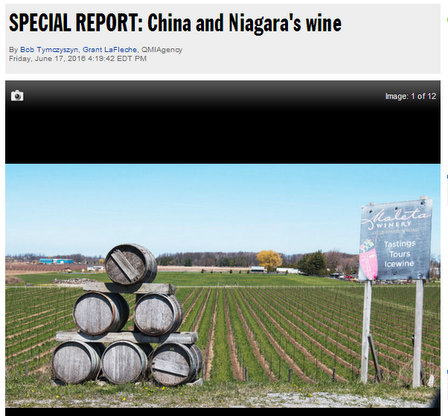By Jim Boyce | I went on a Niagara tour three years ago—an eye-opener that took in the diverse blend of Colineri, Coyote’s Run, Les Charmes and Ravine in St. David’s Bench—and regularly asked at these places if their wines were sold in China. The standard response: lots of Chinese visitors / investors want to buy all of the wine but there is already ample demand in Canada to manage.
Given that interest in Niagara, and the rise of Chinese investment in the world’s other wine regions, I wasn’t surprised by this recent newspaper story by Bob Tymczyszyn and Grant LeFleche
“Increasingly, those in control of Niagara’s most lucrative industry aren’t from Niagara. They aren’t even based in Canada. They’re in China,” it reads. “Chinese business interests have bought up several Niagara wineries, in whole or in part, in the last few years, sinking millions into the industry. They often use Canadian agents to complete their transactions and run their Niagara enterprises, but the controlling interests are ultimately found on the far side of the Pacific Ocean.”
The report estimates the investment at more than CAD30 million and describes the “forces” behind it as “a powerful cocktail of business savvy, market fads, corruption, global economics and ego.”
Interestingly, a professor Luke Chan says the driving force has little to do with grapes: “the root cause isn’t a desire to make wine, but to make money. Land, not grapes, is the real factor at play.”
I guess that’s also no surprise given the extremely high cost of land in China, whether for agricultural, commercial or residential use. To give a personal example, a one-bedroom apartment in my Beijing neighborhood would fetch CAD1,000,000 or more. And the cost of buying every unit in just five floors of my nearly 25-story building, which is fairly old by local standards, would be higher than all of the Chinese investment in Niagara wineries cited in the report.
While the authors cover several concerns with the investments, such as wineries being used to park cash (“this is going to inflate [land] prices over the years”) or a case where a buyer  ripped out 50-year-old vines for red wine and replaced them with varieties for ice wine, others note it can be healthy and that everyone from Americans to Italians to Japanese have been part of Niagara history.
Paul Bosc, owner Les Charmes, cites Constellation‘s purchase of major producer Vincor: “Right off the bat, it created greater credibility for the Canadian wine industry. I think that’s the key.â€
There’s plenty more in this story, including how China’s crackdown on spending by officials is impacting wine sales, the prospects for still wine exports, including for whites, to China, and that favorite topic when it comes to the Great White North, ice wine.
That’s one part of the article that is off, namely, quotes that “They [the Chinese] don’t know how to make real icewine, though. So these knock-offs are mostly just syrup. But because there isn’t a wine culture, many people do not know the difference.â€
It’s true there are many ice wine knockoffs in China and lots of consumers are unable to tell fakes from the real thing. But it’s also true this country makes good ice wine, particularly in the northwest province of Liaoning. That includes one of the big three produces, Changyu, which has three ice wines listed at BBR in London and has done very well in taste tests.
In any case, this piece is well worth a read. Get the full story here.

Get the free Grape Wall e-newsletter by signing up below.
Sign up for the Grape Wall newsletter here. Follow Grape Wall on LinkedIn, Instagram, Facebook and Twitter. And see my sibling sites World Marselan Day, World Baijiu Day and Beijing Boyce. Grape Wall has no advertisers, so if you find the content useful, please help cover the costs via PayPal, WeChat or Alipay. Contact Grape Wall via grapewallofchina (at) gmail.com.
Leave a Reply
You must be logged in to post a comment.